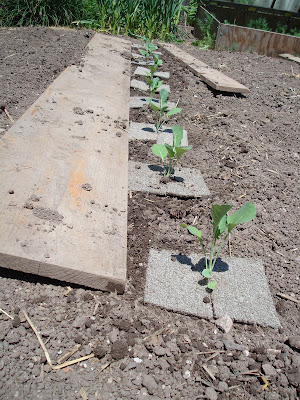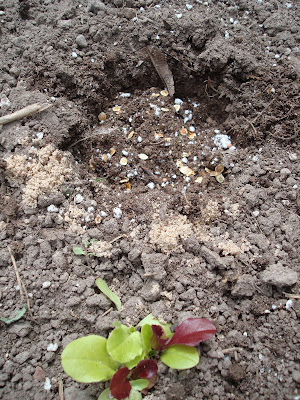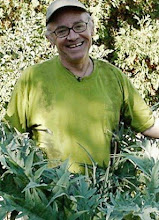 No name miniature potted rose
No name miniature potted rose The new garden space double dug at last.
The new garden space double dug at last. 84 tomatoes in place. The next job will be to start them growing vertically.
84 tomatoes in place. The next job will be to start them growing vertically. Apollo broccoli
Apollo broccoli Root maggot carpet guard that will expand as the plants grow
Root maggot carpet guard that will expand as the plants grow I use an old weight bar to punch my parsnip holes
I use an old weight bar to punch my parsnip holes Compost in the hole.
Compost in the hole. Topped off will potting soil and seeded with parsnips while inter planted with lettuce.
Topped off will potting soil and seeded with parsnips while inter planted with lettuce. The smaller holes are for the salsify.
The smaller holes are for the salsify. Beet transplants ready for a short 5 ft row.
Beet transplants ready for a short 5 ft row. The beets were thinned to 2 plants cell.
The beets were thinned to 2 plants cell. These are the survivors of the first graft attempt.
These are the survivors of the first graft attempt. The graft union.
The graft union. This graft union could be more complete but I think with growth it will close off.
This graft union could be more complete but I think with growth it will close off. The EARTHBOX false bottom with water reservoir.
The EARTHBOX false bottom with water reservoir. This is the fill tube that one uses.
This is the fill tube that one uses. My soil mix was half compost and half potting mix.
My soil mix was half compost and half potting mix. Filled EARTHBOXs ready for planting.
Filled EARTHBOXs ready for planting. Peppers planted and this experiment begins.
Peppers planted and this experiment begins.A week ago today my garden thermometer registered 96 degrees - that's a WOW for May in Wisconsin. Plus we are back into the "no rain" cycle of last year - not good even though the rain barrels are still full, more than two weeks without precipitation is not good for garden work.
The enlargement of the garden space is complete for now. I double dug the new space. The sod is at the bottom of the turned earth and I got down to the hard compacted clay subsoil that was really dry and hard. The plan now is to plant in this new ground some of the vine crops and maybe the cardoons as I have plenty of seedlings. Then in the fall, I will add the peat moss and hopefully the sod will have had a chance to deteriorate and make the tilling a bit easier. I will have to be on the lookout for some more straw as the four bales in the little house will just about do the tomatoes and potatoes.
I had one of the best tomato seedling crops I have had in a long time. The plants were healthy strong and ready to go into the ground this weekend - early by a week for me. I took the flats out the the space and thought I did a good job of deciding what should go where. Planting was fun and the ground was really hot. I planted away and then started to ask - where is that plant? And - where are those seedlings? It was then I realized that I was missing a whole flat of plants and the rows were full! So I pulled plants and replanted with my missing plants. I sure hope my notes are right after this. The final count is 84 plants in the tomato patch. Yes, they are rather close but because they are grown vertically I think I can get away with it. Only time and harvest will tell. Besides, we like tomatoes; we really like tomatoes.
I got my potatoes late again this year. I will have to remember to get them before May 1st next year. I cut them and let them dry and planted them early in the week. Sorry I forgot to get pictures but I spaced my potato pieces about 6 inches apart in my trenches. I have the soil mounded on one side to pull in as the plants grow. The varieties are Carola, Inca Gold, All Red, and a French Fingerling. The last two varieties are the ones I am most interested in because of the color of the tuber flesh. I did not use the tower method of last year because I was not happy with the results. I did not save as much space as I thought and the plants on the south side of the tower shaded the plants on the north side. As a result I am back to trying rows and because potatoes are not high on the food list here we will just have to see if this is a crop that will stay in the garden. I planted broccoli this week in a row next to the potatoes. I used the root maggot guards that I made last year around the base of each plant. These are made from the carpet we removed last season. The carpet will expand as the broccoli stem grows but will protect the plant from root maggots that lay their eggs on the carpet and when the eggs hatch they cannot get into the soil by the stem and later in the season destroy the crop. They worked well last year and should again.
I also got the parsnip row seeded with Javelin Hybrid. I will include a short video showing how I make the hole for the roots to grow into. We really love parsnips as the first entry of 2010 shows. This year I had enough screened compost to fill the holes with instead of potting soil. I used the potting mix in the top several inches and again sowed radish seeds in the spots to help mark the parsnip site till the seed sprouts - about 20 days later. I inter-planted with lettuce and in another row I am experimenting with salsify, done the same way. I punched holes for this root crop and sowed the seed thick and will thin as the plants grow. I even punched holes for my daikon radishes that are in a cold frame. Another root crop that was planted this week were the beet transplants. Last year I transplanted both beets and carrots and the success was good enough to try that again. The beets are a cylinder beet called Rodina and the carrots are the a short round type; Parisienne is the first try and I have some other seed that I will try later.
The experiment with grafted tomatoes is on-going. The pictures included show some of the result. I grafted a dozen plants and by now I have four that seem to have taken. Not too bad a result - 30% - much better than nothing. I replanted seed and am going to go at it again. I figure I have all summer to get the grafting part right and then I think I can manage the planting part. Even if I don't get a fruiting plant this summer as long as I have the technique worked out I can continue the experiment next summer. But for now I am happy that any seemed to have grown. I did learn several things on this first try. One: make the cut on the root stock below the cotyledons so they do not grow as several did and thus causing the scion to not take. Two: remove more leaves from the scion as the amount of leaves that the scion can support till the graft takes is minimal. Thirdly: graft smaller; my roots stock was just too big and thus my clips did not fit properly. So next time I will graft smaller diameter stock and hope for better results.
This season we are using the commercial "EARTHBOX" for some patio pepper plants. I have seen the product in production in Florida and was amazed at just what was capable in these containers. The system has a water reservoir in the bottom that makes watering plants more efficient. I filled my boxes with a mixture of potting mix and compost and the half of the fertilizer and soil amenities supplied by the manufacturer. The wheelbarrow full of soil was my mixing site and even with that much I need to make an additional small batch of soil to fill the second box. I let them sit for a week and planted a mixture of peppers in them - Franks, Gourmet, Carmen, and Healthy Choice - all sweet types. They will be in front of the greenhouse when the cold frames are moved out and along with he fig tree should make for an nice display and hopefully a good crop of peppers not plagued by slugs or earwigs.
Happy Gardening

Your hole punch method is clever. I was interested too to see you growing beets from transplants. I've had no luck doing them that way as the soil mass around the roots often breaks apart on me when I remove the seedlings from their cells. Your photo seems to show you don't have that problem. I like the carpet idea too. All very interesting. Thanks and happy gardening to you!
ReplyDeleteHi Richard,
ReplyDeleteBeet transplants are not something one is supposed to do but it works for me. I put multiple seeds in the cells and then I thinned to two plants. I would suggest that when you take the transplants out that you water the cells before, so the soil sticks together better. Dry potting mix will fall apart without heavy root development. Any carpet will do but indoor/outdoor is the best.
Happy Gardening